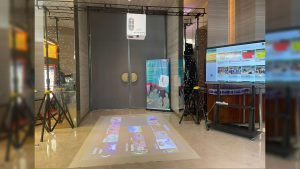The professional audiovisual industry is at a turning point. For decades, AV professionals have relied on purpose-built hardware HDMI matrix switchers, HDBaseT extenders, and proprietary distribution systems to move video signals from point A to point B. These solutions served their purpose well, but as 4K resolution becomes prevalent and expectations for image quality reach new heights, the limitations of traditional infrastructure have become impossible to ignore.
Enter Software Defined Video over Ethernet, or SDVoE a technology that is fundamentally rewriting the rules of professional video distribution. Built on standard 10-Gigabit Ethernet(10GbE) networks, SDVoE represents more than just another transmission protocol. It signals a paradigm shift in how we conceive, design, and deploy AV systems, dissolving the boundaries between dedicated hardware and intelligent, networked infrastructure.
Why 10GbE Matters
SDVoE is an open standard enabling uncompressed 4K video, audio, and control data to extend across standard 10-Gigabit Ethernet networks unlocking capabilities legacy systems cannot match.
The 10GbE bandwidth is critical. Uncompressed 4K video at 60Hz with 4:4:4 chroma subsampling and HDR demands approximately 18 gigabits per second. Traditional HDMI handles this point-to-point over limited distances. HDBaseT extends reach but introduces compression. SDVoE delivers this bandwidth over network-grade cabling while maintaining pixel-perfect fidelity and sub-100-microsecond latency.
This zero-compression quality and near-instantaneous switching creates previously unattainable possibilities. Radiologists confidently review high-resolution scans, knowing no diagnostic detail is lost, Broadcast directors switch between 4K feeds without visual lag, Corporate presentations display with full color accuracy and clarity.
Beyond signal quality, SDVoE’s true power lies in scalability. Unlike traditional matrix switchers with fixed configurations, SDVoE systems are inherently flexible. The “matrix” is the network itself. Adding capacity means deploying additional endpoints and switches, not replacing entire systems. This architectural flexibility aligns perfectly with dynamic enterprise needs where AV requirements evolve continuously
The AV-IT Convergence Accelerates
Perhaps SDVoE’s most significant implication is accelerating AV and IT convergence. For years, these disciplines operated separately AV on dedicated cabling, IT managing data networks. This created inefficiencies, duplicated costs, and limited integration.
SDVoE fundamentally changes this. By running AV over standard Ethernet infrastructure, it enables true convergence. Video, audio, control, and data coexist on unified networks managed through common IT practices, bringing centralized management, reduced cabling complexity, and leveraging existing network investments.
For IT administrators, this means applying familiar tools managed switches, VLANs, multicast routing to AV distribution. For AV professionals, it demands new competencies: network fundamentals, IP addressing, QoS configuration, and bandwidth management. The best integrators bridge both worlds, speaking fluently in AV specifications and network architectures.
This convergence is particularly visible in Asia-Pacific markets, where infrastructure development and smart building initiatives create fertile ground for SDVoE adoption. In India, corporate campuses, government command centers, and airports increasingly specify SDVoE-based systems demanding reliability, scalability, and future-readiness.
Beyond Simple Switching
SDVoE’s software-defined nature enables sophisticated video processing that traditional hardware struggles to match. Modern systems perform multi-view layouts, video walls, scaling, cropping, and real-time layering all through software rather than dedicated hardware.
This transforms system economics. Instead of separate scalers and processors, integrators deploy general-purpose endpoints and enable features through software licensing. This reduces upfront costs and creates upgrade paths without equipment replacement. Systems gain new capabilities through software updates future-proofing unimaginable with traditional architectures.
In control rooms, operators dynamically reconfigure displays and create custom layouts without technical intervention. Retail environments distribute content across hundreds of screens with individualized scaling. Educational spaces adapt between lecture capture, multi-source presentation, and remote participation seamlessly.
The Economic Equation
SDVoE may require higher upfront investment, but the cost advantages become clear in large-scale deployments and long-term use. Traditional matrix switchers impose hard scaling limits. Expanding capacity often means replacing entire chassis or adding expensive blade modules. SDVoE systems scale incrementally—each new endpoint requires only an encoder or decoder and network ports. In large deployments, manufacturers estimate infrastructure cost reductions of up to 50 percent compared to conventional approaches.
SDVoE systems leverage commodity networking hardware that benefits from continuous IT industry cost reduction. As 10GbE switches become increasingly affordable, economic advantages strengthen. Standard Cat6A or fiber cabling further reduces costs and simplifies maintenance.
For integrators, this creates compelling value propositions in projects with growth potential. The message is clear: invest in intelligent infrastructure that adapts, not fixed hardware that constrains.
Current Challenges
Despite its advantages, SDVoE adoption requires confronting practical challenges. The need for robust IT infrastructure cannot be overstated. These systems demand 10-Gigabit managed switches with proper multicast support, VLAN segmentation, and QoS configuration. Network stability directly impacts AV performance, making collaboration between AV and IT teams not just beneficial but essential.
Bandwidth management requires careful planning. While a single 4K SDVoE stream consumes roughly 10Gbps, networks must accommodate multiple simultaneous streams, control traffic, and other data. This necessitates thoughtful network architecture, often employing fiber backbones and strategic switch placement to avoid bottlenecks.
Training and skill development are important considerations. AV professionals need to learn networking basics, including concepts like IGMPv3, spanning tree protocols, and network latency. On the other hand, IT teams must understand AV-specific needs like latency sensitivity and consistent data streams. Successful SDVoE systems require AV and IT teams working together.
Road Ahead
Looking forward, SDVoE’s evolutionary path is closely tied to network technology advancement. Current 10GbE infrastructure handles 4K beautifully, but 8K resolution quadrupling pixel counts will demand significantly more bandwidth. Uncompressed 8K at 60Hz with full color depth approaches 48Gbps, pushing well beyond 10GbE capabilities.
This is driving interest in 25-Gigabit and 40-Gigabit Ethernet infrastructure. These higher-speed networks are already deployed in data center environments and are gradually becoming viable for AV applications. SDVoE’s software-defined architecture positions it perfectly for this transition the same fundamental protocols and control systems can scale to higher bandwidth networks as they become cost-effective.
High frame rate video, immersive formats, and augmented reality applications will further drive bandwidth demands. The industry is also exploring more efficient coding techniques within the visually lossless paradigm, potentially using sophisticated algorithms that maintain perceptual perfection while reducing bandwidth requirements slightly.
The flexibility inherent in SDVoE’s design means these advancements can be incorporated without fundamental architectural changes. Systems designed around SDVoE principles today can evolve to support tomorrow’s requirements through network upgrades and software enhancements rather than complete replacement.
The New Era
The rise of SDVoE represents more than technological evolution, it signals a fundamental reconceptualization of what video distribution systems can be. The transition from physical matrix switchers to intelligent, network-based signal orchestration mirrors the broader digitalization transforming every industry.
For system designers and integrators, this demands new thinking. Success requires moving beyond traditional AV expertise to embrace network engineering, software configuration, and IT collaboration. Those who make this transition position themselves as invaluable partners capable of designing systems that truly align with modern organizational needs.
For end users, SDVoE promises systems that don’t just meet today’s requirements but adapt to tomorrow’s innovations. The ability to scale gracefully, upgrade through software, and integrate seamlessly with broader IT infrastructure represents genuine future-proofing in an industry where technological obsolescence is a constant threat.
As we move deeper into the 4K era and toward 8K and beyond, SDVoE stands at the forefront of professional AV not simply as a technology, but as a vision of what becomes possible when video, data, and control converge into a single, seamless, uncompromised network. The revolution is here, and it’s traveling over Ethernet.





